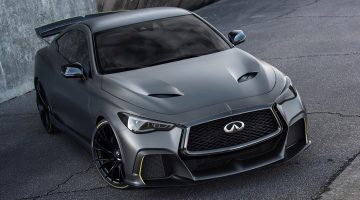The now decade-old 3.7-litre ‘VQ’ V6 has been retired, and its successor hints at a more performance focused future for Infiniti. How? crankandpiston asks the men in the know
—
“Could Infiniti launch a performance sub-brand?”
It’s a question that, clearly, Infiniti President Roland Krueger and vice president of product strategy Francois Bancon have heard before, given the small grin that appears at the corner of the latter’s mouth. It’s a question we’ve been mulling for some time though, given that, during the recent launch of the new Q50 400 Red Sport, Infiniti was adamant its new performance weapon should not be thrust into the same bracket as a BMW M3 or a Mercedes-AMG C63.
I’m intrigued though. Much has been made of the new twin-turbo V6 at the heart of the new Red Sport, its performance potential and the long-term benefits of such an engine. Is it too much to consider that an Infiniti M3-bater is just around the corner? I’m struck by a surpassingly frank answer…
“We want to go there. There is no question about it,” Francois explains. “We want to go there. There is no question about it. We’ll probably use an existing car, and probably as an idea – it’s an idea, not a project at this time – maximise the collaboration with The Alliance. I’m not going to tell you more, but of course, we are working on this. The alternative is you go exclusive high performance, which is stupid because anyone can do this. But that’s not what Infiniti is about.
“Much has been made of the new twin-turbo V6 at the heart of the new Red Sport. Is it too much to consider that an Infiniti M3-bater is just around the corner?”
“So, remember we are in the ‘sport’ part of the segment, not the ‘ultimate sport’ department. It’s still a huge investment and we are a small company, so we need to be careful about how we spend our money – there are people who remind us when we don’t! – and we don’t want to make an expensive car. We are not Ferrari and we do not intend to be. We are, what you might call, mass-market premium, like BMW M, Mercedes–AMG or Audi RS. But we have to be smarter than that. The future is not just about big engines and big power. We need to be smarter than that. Hence the new twin-turbo V6.”
The reality at the moment then is on a much smaller scale, though that’s certainly not to dab the new V6 – the latest of a brand new ‘VR’ family of powerplants – with faint praise. These six-cylinders after all replace the ‘VQ’ 3.7-litre V6 that’s been in service for well over a decade in almost every model on Infiniti’s line-up. It also, significantly, marks the transition from natural aspiration to turbocharging.
“The 3.7 is an excellent engine, but it’s been around for more than 10 years and we are almost at the end of the game,” Francois continues. “Turbocharging was a big decision we actually made five years ago for two reasons. First, package-wise it’s more effective because it’s lighter, and secondly, new regulations meant it was really the only way to go, not just with fuel efficiency but the potential for future technology too. So yes, it was a hard decision but the right one for a new generation.”
That ‘the future’ is a buzzword should hardly be a surprise given that Infiniti has debuted Direct Adaptive steering that replaces connecting rods with digital sensors, a new hybrid engine courtesy of its links with ‘The Alliance’ – i.e. the Renault Group and Daimler – and the Engineering Academy, honing talent for both the road and Infiniti’s Formula 1 links. Make no mistake, for Infiniti, the new twin turbo V6 is crucial.
Fuel consumption has improved by 6.7 percent, with both peak power and torque now available across a wider range of revs thanks to a faster acting turbine and the valve timing system, the latter of which delivers quicker reactions to driver inputs. Even the size of the V6 is significant, the 19 percent downsizing reducing overall weight significantly.
“It’s a technical marvel,” Roland chimes in. “Our engineers have worked for close to 20 years on this project, and we have more than 300 patents on this technology. It’s the next step of showing that the brand is focused on having premium luxury vehicles: we say it has the power of a V6 with the economy of a four-cylinder. It just fits at the right time, into the right spot and the right vehicle” – Roland’s clearly been practicing that one – “and we are very excited.”
“The latest of a brand new ‘VR’ family of powerplants marks the transition from natural aspiration to turbocharging”
Back to the question of the performance sub-brand. Clearly the interest is there, and now so too is the foundation of a performance engine range, and while the Q50 may already be getting on in years, such prominent focus on the years to come suggest, surely, a future generation is being earmarked.
“I think if we do something, we need to do something Infiniti specific and unique, that’s absolute,” Roland explains. “Look at the Q50 400: that is already a statement, and definitely in the right direction. Of course there are more ideas in the bank, but this is our main focus right now.”




